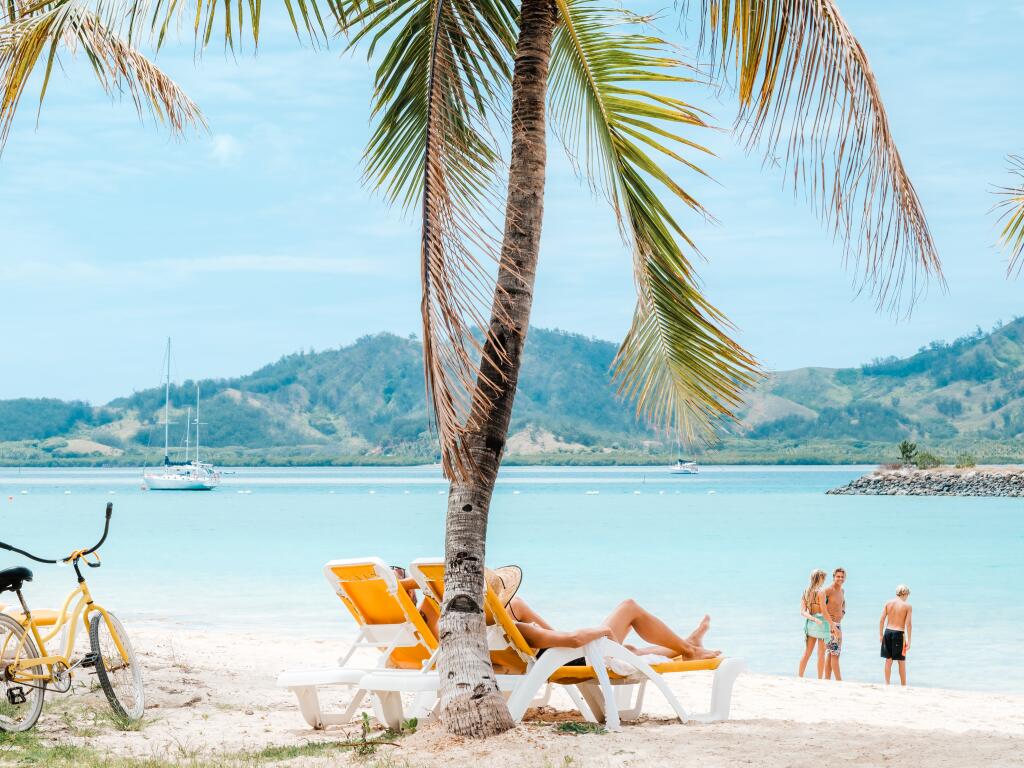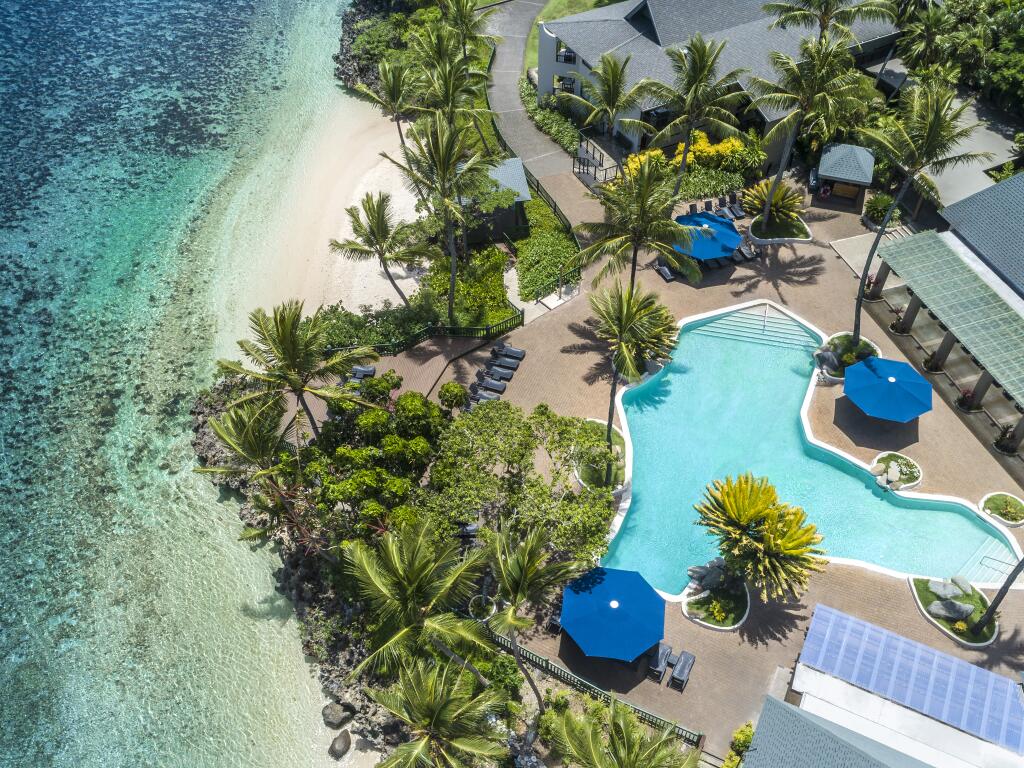Best Time to Visit Fiji in 2025
The best time to visit Fiji is during the dry season, from May to October, when the weather is sunny, rainfall is minimal, and the beaches are at their best. For those seeking a quieter experience with fewer crowds, the period between late October and early November is ideal for enjoying Fiji's tropical charm.
However, Fiji is a wonderful destinations know for the year-round warm weather, always an amazing place to go for snorkelling and endless sunbathing. So there no bad time to visit Fiji, but depending on what sort of holiday you want, some months may be better for you than others when you consider school holiday crowds, affordability, events, and conditions for recreational activities.
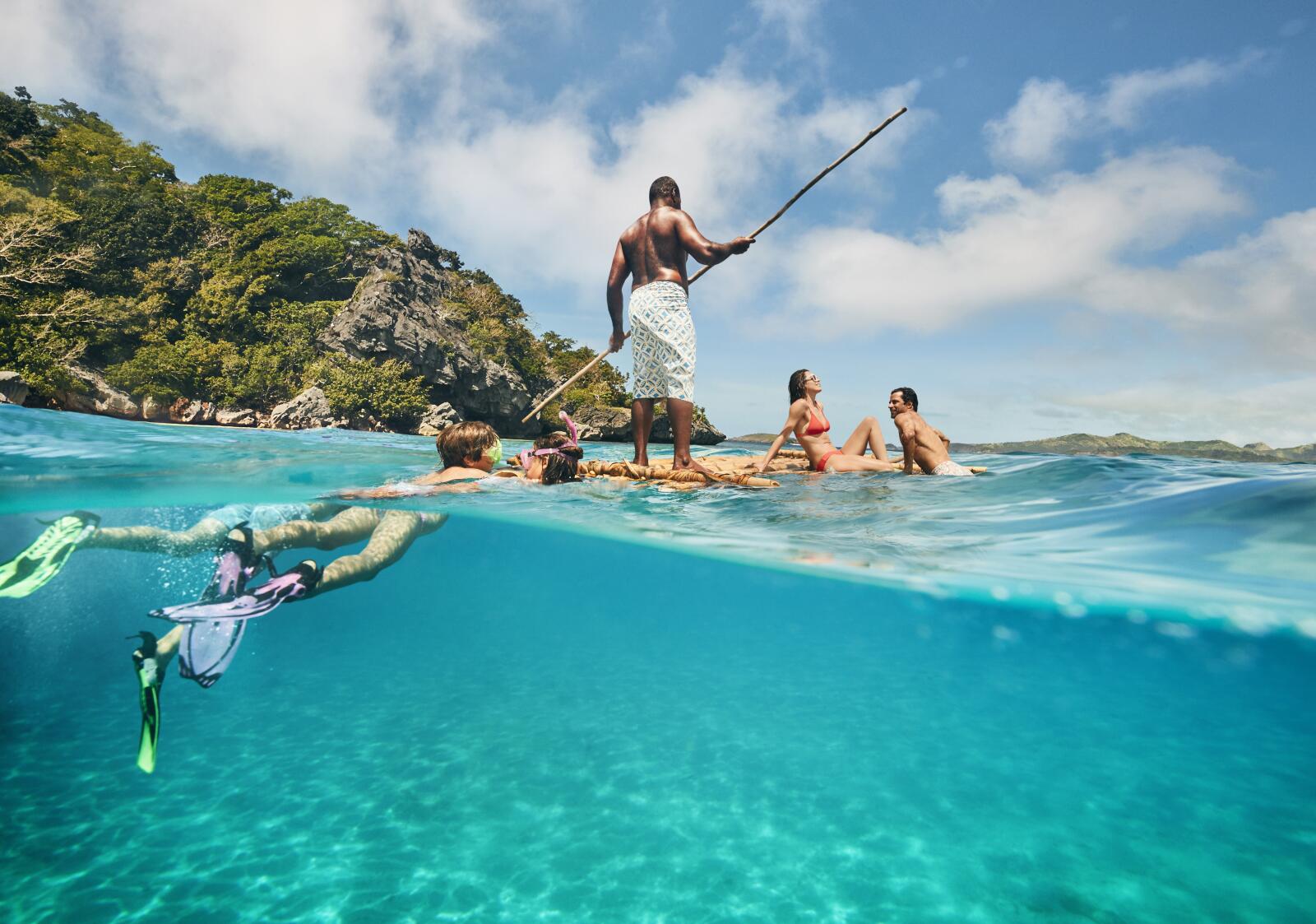
When Is The Most Popular Time To Visit Fiji?
July to August is usually the most popular time to visit Fiji, as many families choose to travel during the Australian and New Zealand winter school holidays. Over the Christmas/New Year period, Fiji resorts are often filled with families taking a break during the Southern Hemisphere summer holidays.
Peak and off-peak seasons may be one of the biggest factors affecting your decision about when to travel, as the most popular times to visit Fiji are more expensive and generally busier.
Table Of Contents
1. When Is The Best Time To Go To Fiji For A Holiday?
2. Best Time To Visit Fiji For A Quiet Holiday
3. Best Time To Visit Fiji For Dry Season
4. Best Time To Visit Fiji With Your Family
5. Best Time To Visit Fiji For Budget Stays & Couples Getaways
6. Weather Across Fiji's Regions
7. Best Time To Visit Fiji For Surfing
8. Best Time To Visit Fiji For Diving And Snorkelling
9. Best Time To Visit Fiji For Hiking And Nature Walks
Everything You Need To Know About Travelling to Fiji
Considering a trip to Fiji? Learn more about the stunning tropical getaway below. If you can't find the answers you're looking for, head over to our Fiji Know Before You Go page for more information.
Experience Paradise With TravelOnline's Best Fiji Deals
Fiji holiday packages are the best way to make the most of your tropical escape. Combine the essentials like flights and accommodation with exciting tours and attractions to save you time and money. Leave the planning to our holiday package specialists and enjoy the peace of mind that comes with value for money, with a holiday guaranteed to be remembered long after you've unpacked your bags.
When Is The Best Time To Go To Fiji For A Holiday?
Fiji's year-round tropical weather means there's always a good time to visit. However, each month offers different experiences, weather, activities and fun things to do in Fiji
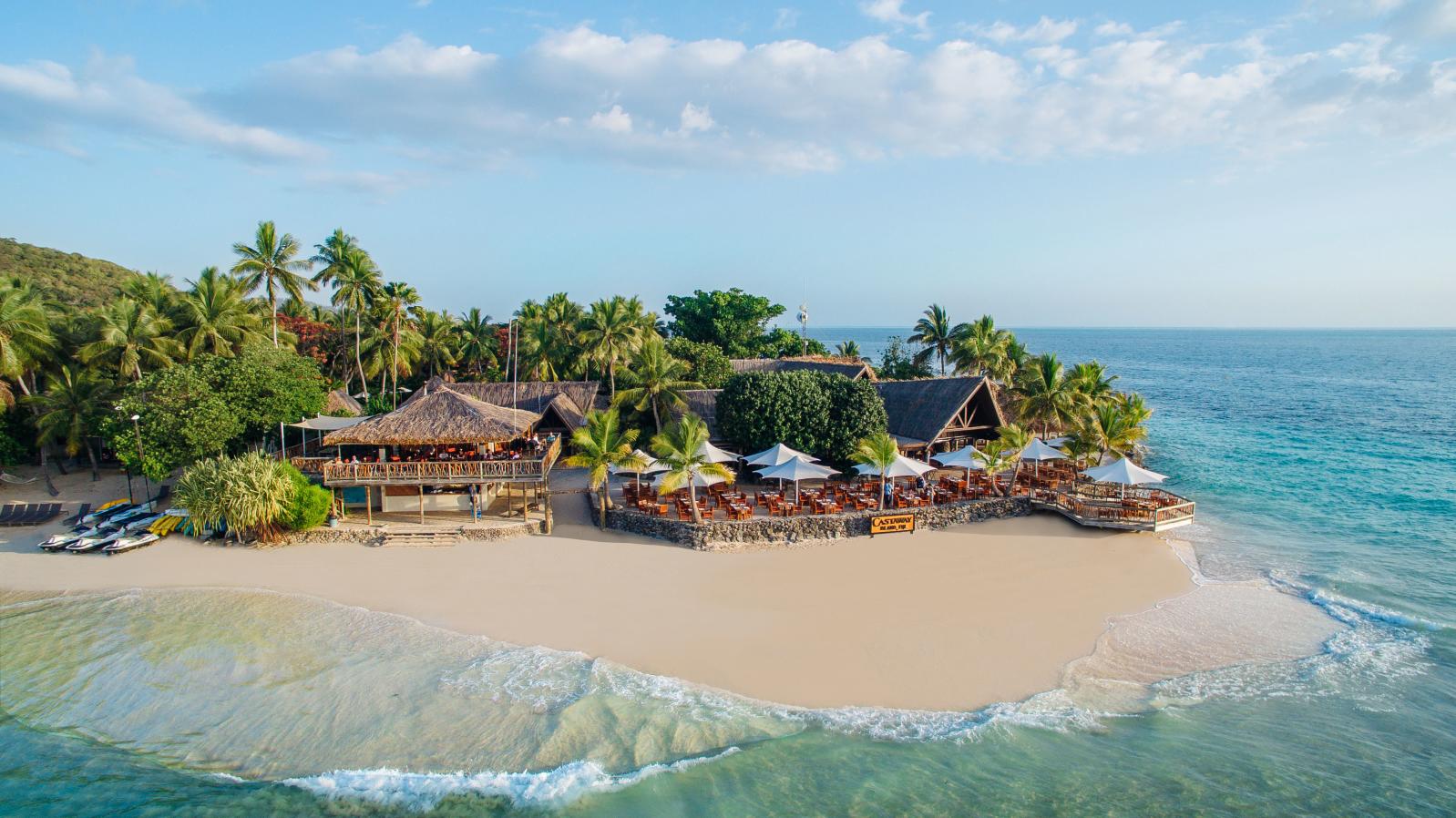
Best Time To Visit Fiji For A Quiet Holiday: January To March
Weather Details: January through March is Fiji's peak wet season. Temperatures range from 25°C (77°F) to 31°C (88°F), with high humidity and frequent afternoon showers or evening thunderstorms. The rain usually comes in short bursts, and there are still sunny intervals in between.
Cyclone Awareness: This period is also cyclone season in the South Pacific, though cyclones are relatively rare. Visitors should keep an eye on weather reports, as Fiji's alert systems are reliable and give early warnings.
Crowds: The combination of wet weather and post-holiday travel slowdown makes this a low season. Resorts and popular attractions are quieter, allowing for a more relaxed atmosphere.
Activities:
Snorkelling: The wet season keeps the water warm, perfect for comfortable snorkelling, especially with fewer tourists around.
Rainforest Adventures: This is the best time to explore Fiji's rainforests, as lush vegetation is at its peak. Nature trails, waterfall hikes, and eco-tours are especially beautiful with vibrant greenery.
Local Experiences: Engage with the local culture by visiting villages, exploring markets, or taking part in cooking classes, which are unaffected by weather.
Events:
Fiji Pro Surfing Competition (January): Held at Cloudbreak on Tavarua Island, this event draws international surfers and is a highlight for surfing enthusiasts.
Travel Tips: Pack light, quick-drying clothes, and bring a waterproof bag for day trips. This period is also known for lower prices on flights and accommodation, making it ideal for budget-conscious travellers looking for peace and quiet.
Best Time To Visit Fiji For Dry Season: April To June
This is the period of time where Fiji transitions to its dry season, perfect for surfing and diving!
Weather Details: April signals the end of the wet season, with less rainfall and more sunshine. Temperatures average between 24°C (75°F) and 29°C (84°F). May and June bring ideal beach weather with sunny skies and cooler nights.
Crowds: Crowds start to pick up in June, particularly as the dry season begins. However, April and May are relatively peaceful and provide excellent value.
Activities:
Surfing: April marks the beginning of the prime surfing season, especially around areas like Cloudbreak and Frigates Pass, with consistent swells.
Snorkelling and Diving: With clearer water and lower rainfall, April to June offers some of the best underwater visibility. Coral reefs are vibrant, and divers may spot turtles, reef sharks, and a range of tropical fish.
Island-Hopping: Dry and sunny weather is perfect for exploring Fiji's islands. Day cruises and multi-day island-hopping tours are popular, and conditions are ideal for water activities.
Events:
Easter Celebrations: Fijians celebrate Easter with enthusiasm. Visitors may encounter local parades, church services, and traditional feasts.
International Jazz and Blues Festival (May): Held on Denarau Island, this festival attracts local and international musicians and creates a lively atmosphere for music lovers.
Travel Tips: Bring layers for cooler evenings, especially in June. If you're visiting popular destinations like the Coral Coast, booking ahead is recommended to secure your preferred accommodation.
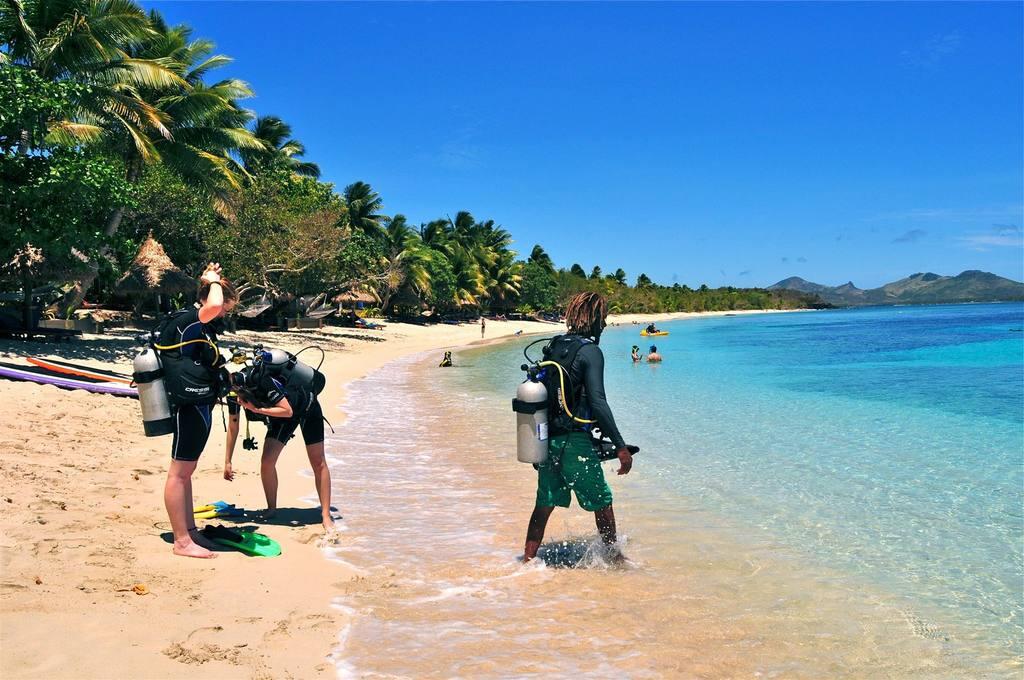
Best Time To Visit Fiji With Your Family: July To September
July through to September is the peak dry season, which is great for Families and adventure seekers.
Weather Details: This is Fiji's dry season, featuring low humidity, clear skies, and temperatures between 22°C (72°F) and 28°C (82°F). Rainfall is minimal, making this an ideal time for outdoor activities.
Crowds: July and August are Fiji's busiest months due to school holidays in Australia and New Zealand, drawing families and groups. September sees slightly fewer crowds but still experiences high travel demand.
Activities:
Snorkelling and Diving: With excellent water clarity, these months are ideal for underwater adventures. Popular spots include the Mamanuca Islands, Yasawa Islands, and Coral Coast.
Hiking: Cooler weather makes it comfortable for long hikes. Explore Taveuni's Bouma National Heritage Park, where you'll find waterfalls, scenic lookouts, and lush forest.
Cultural Activities: Enjoy traditional Fijian fire-walking ceremonies, local handicraft markets, and village visits, all in a vibrant atmosphere created by the influx of visitors.
Events:
Bula Festival (July): Held in Nadi, this festival celebrates Fijian culture with traditional dance, music, and food stalls.
Hibiscus Festival (August): Fiji's largest festival, hosted in Suva, features beauty pageants, parades, cultural performances, and food markets.
Travel Tips: Book accommodation and tours several months in advance. Pack a light sweater for the evenings, especially if you plan to spend time by the coast, where temperatures can drop slightly.
Best Time To Visit Fiji For Budget Stays & Couples Getaways: October to December
This is the shoulder season, which makes October to December a wonderful options for budget travellers and couples wanting a holiday.
Weather Details: October and early November offer some of the best weather in Fiji, with warm temperatures and little rain before the wet season begins. Late November and December see increased humidity and more frequent rain showers.
Crowds: October and early November are relatively quiet, providing a peaceful atmosphere ideal for couples and honeymooners. Crowds start to increase in late December as the holiday season approaches.
Activities:
Beach Relaxation: October is one of the best months for a beach holiday in Fiji, with sunny days and pleasant temperatures. Relaxing on the beaches in Yasawa or Mamanuca Islands is especially enjoyable.
Snorkelling and Diving: October still has clear waters and good visibility for underwater activities. November's warmer water also attracts unique marine life.
Village and Cultural Tours: Enjoy guided visits to local villages, where you can experience Fijian traditions like the kava ceremony, crafts, and cooking.
Events:
Fiji Day (October 10th): This national holiday celebrates Fiji's independence with parades, cultural performances, and community events across the islands.
Diwali (October/November): Known as the Festival of Lights, Diwali is celebrated by Fiji's large Indian community with colourful decorations, festive food, and fireworks.
Travel Tips: October and early November offer excellent value for budget travellers, with lower prices on flights and accommodation. If visiting in December, pack for hot, humid weather and plan for possible rain.
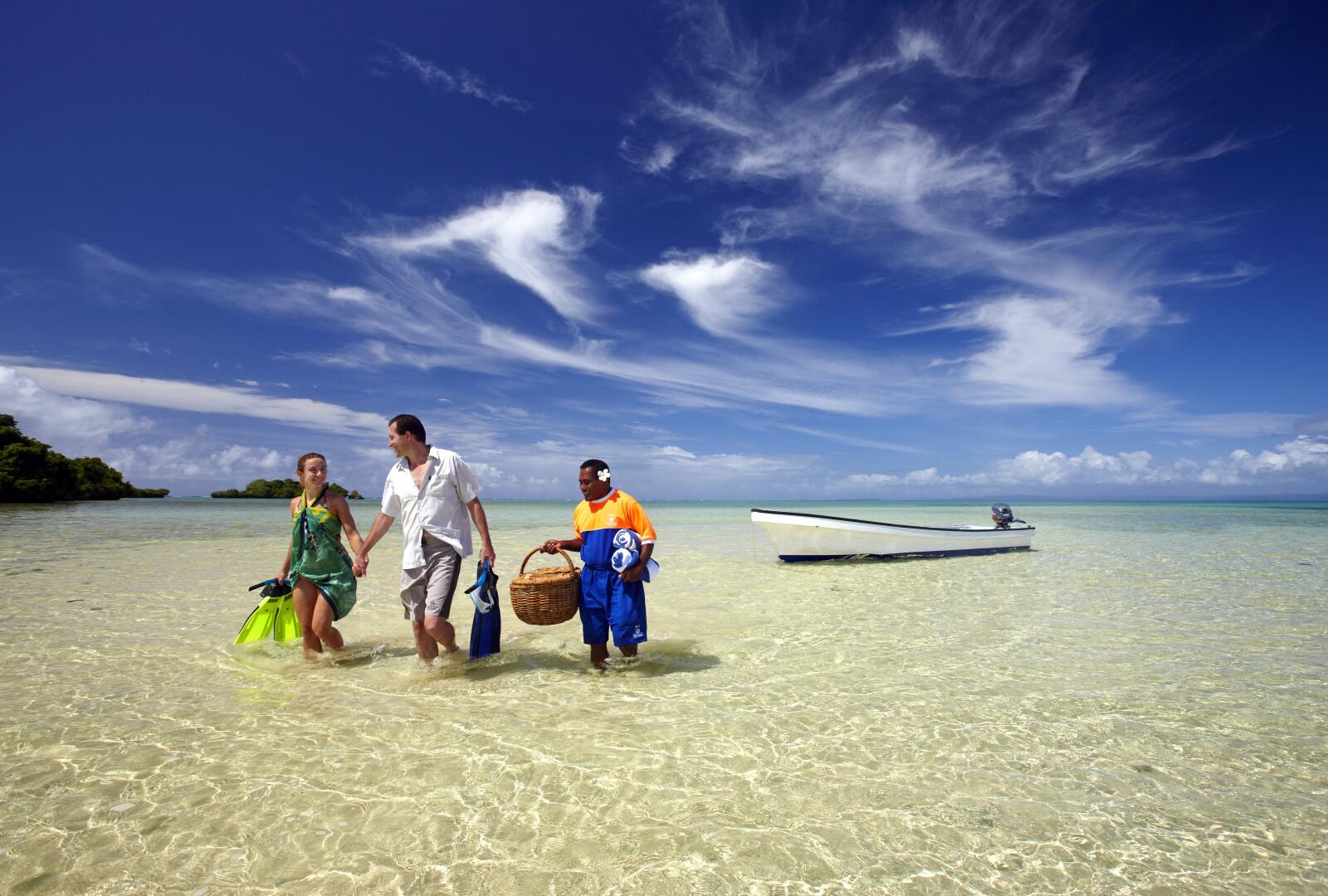
Fiji Holiday Packages
Weather Across Fiji's Regions
Fiji's regions experience subtle but notable differences in climate. Choosing a region with the most favourable weather for your trip can enhance your experience, whether you're looking for sun-drenched beaches, adventure-filled rainforests, or tranquil coral reefs.
Nadi And Denarau Island Weather: Sunny Western Region With Year-Round Warmth
Location: Nadi and Denarau Island are situated on the western coast of Fiji's main island, Viti Levu.
Weather Characteristics: This region generally enjoys drier and sunnier weather than the eastern side of Viti Levu, even during the wet season. Temperatures remain comfortably warm year-round, with averages ranging from 22°C (72°F) in the dry season to 31°C (88°F) during the wet season.
Dry Season (May to October): Nadi and Denarau Island are particularly popular during the dry season, with clear skies, lower humidity, and mild temperatures. This is the best time for outdoor activities and water sports, as the days are consistently warm and dry.
Wet Season (November to April): During the wet season, Nadi experiences occasional rain showers, often short and heavy in the afternoons, followed by sunshine. Because of the rain shadow effect from the mountains, this area receives less rain compared to the eastern regions. Travellers can still expect plenty of sunny days.
Best for: Beach relaxation, family-friendly resorts, and outdoor adventures like golf and island-hopping. Nadi is also the gateway to other regions, making it ideal for those looking to explore multiple areas.
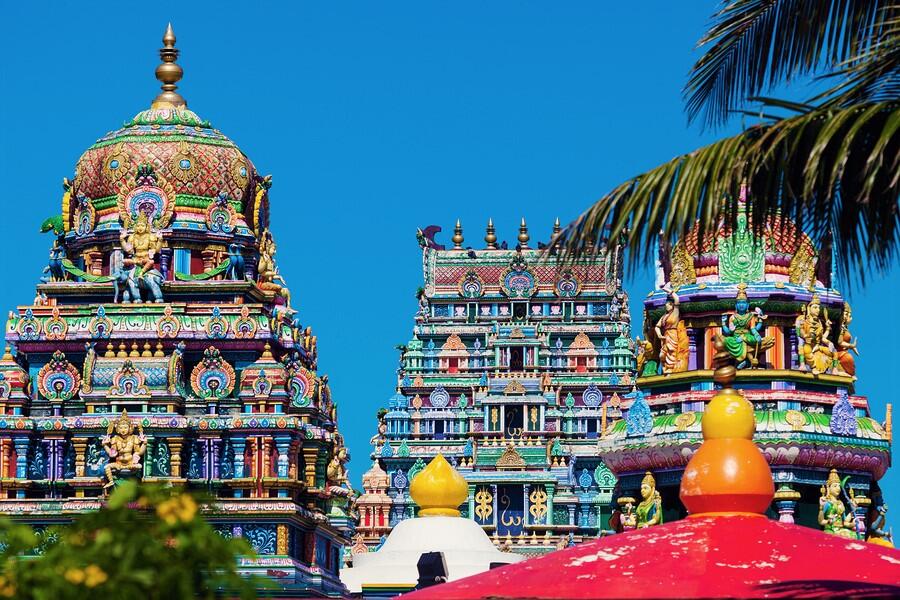
Coral Coast Weather: Consistent Climate With Iconic Coral Reefs
Location: The Coral Coast stretches along the southern coast of Viti Levu, Fiji's largest island.
Weather Characteristics: Known for its coral reefs and picturesque beaches, the Coral Coast offers stable, tropical weather throughout the year. Temperatures here range from 21°C (70°F) to 30°C (86°F), with cooling trade winds that help moderate humidity.
Dry Season (May to October): The dry season is the prime time to visit the Coral Coast. The weather is pleasant, with sunny days, gentle breezes, and little rainfall. Visibility for snorkelling and diving is at its best, as calmer seas and dry weather improve water clarity.
Wet Season (November to April): The Coral Coast receives more rainfall than Nadi due to its coastal geography, especially from January to March. Despite the rain, showers are typically brief, and there are still plenty of opportunities for outdoor activities between rain spells. The reefs are vibrant, and the rain brings lush, green landscapes to the area.
Best for: Snorkelling, diving, and family vacations. The Coral Coast is ideal for travellers seeking access to marine activities and cultural experiences, with several resorts offering easy access to traditional Fijian villages and local tours.
The Mamanuca Islands Weather: Tropical Paradise With Plenty Of Sunshine
Location: This group of small islands lies just off the coast of Nadi, easily accessible by boat.
Weather Characteristics: The Mamanuca Islands enjoy one of Fiji's sunniest climates and are typically drier than other regions. Average temperatures are between 24°C (75°F) and 31°C (88°F) year-round, with minimal rainfall.
Dry Season (May to October): The islands experience warm, dry, and sunny weather during the dry season, making it the best time for beach activities, water sports, and boat excursions. Calm seas provide ideal conditions for snorkelling and diving in the colourful coral reefs.
Wet Season (November to April): The wet season brings occasional rain showers and higher humidity, but the Mamanucas still see plenty of sunshine. Showers are typically short, and the clear skies return quickly, making it a good year-round destination.
Best for: Beach vacations, water sports, and island-hopping. The Mamanuca Islands are ideal for travellers who want a classic tropical getaway with beautiful beaches, warm waters, and luxury resorts.
Taveuni Weather: Fiji's "Garden Island" With Lush Rainforests And Vibrant Flora
Location: Taveuni is located northeast of Viti Levu and is known as Fiji's "Garden Island."
Weather Characteristics: As Fiji's wettest region, Taveuni experiences significant rainfall, especially during the wet season. The climate is ideal for rainforest growth and supports the island's lush landscapes. Temperatures range from 22°C (72°F) to 30°C (86°F) throughout the year.
Dry Season (May to October): Taveuni's dry season is relatively mild compared to other regions, with reduced but consistent rainfall. This is the most comfortable time for hiking and outdoor activities. The flora is still vibrant, and the weather is warm, making it perfect for eco-tours and rainforest exploration.
Wet Season (November to April): The wet season brings heavy rains, especially from January to March, which nourish the rainforests and create spectacular waterfalls. Visitors during this time can witness the island's lush beauty in its full glory, though some trails may be muddy or inaccessible.
Best for: Rainforest hikes, waterfall exploration, and birdwatching. Taveuni's unique ecosystem attracts eco-tourists and nature lovers, with incredible biodiversity, scenic hikes, and breathtaking waterfalls in Bouma National Heritage Park.
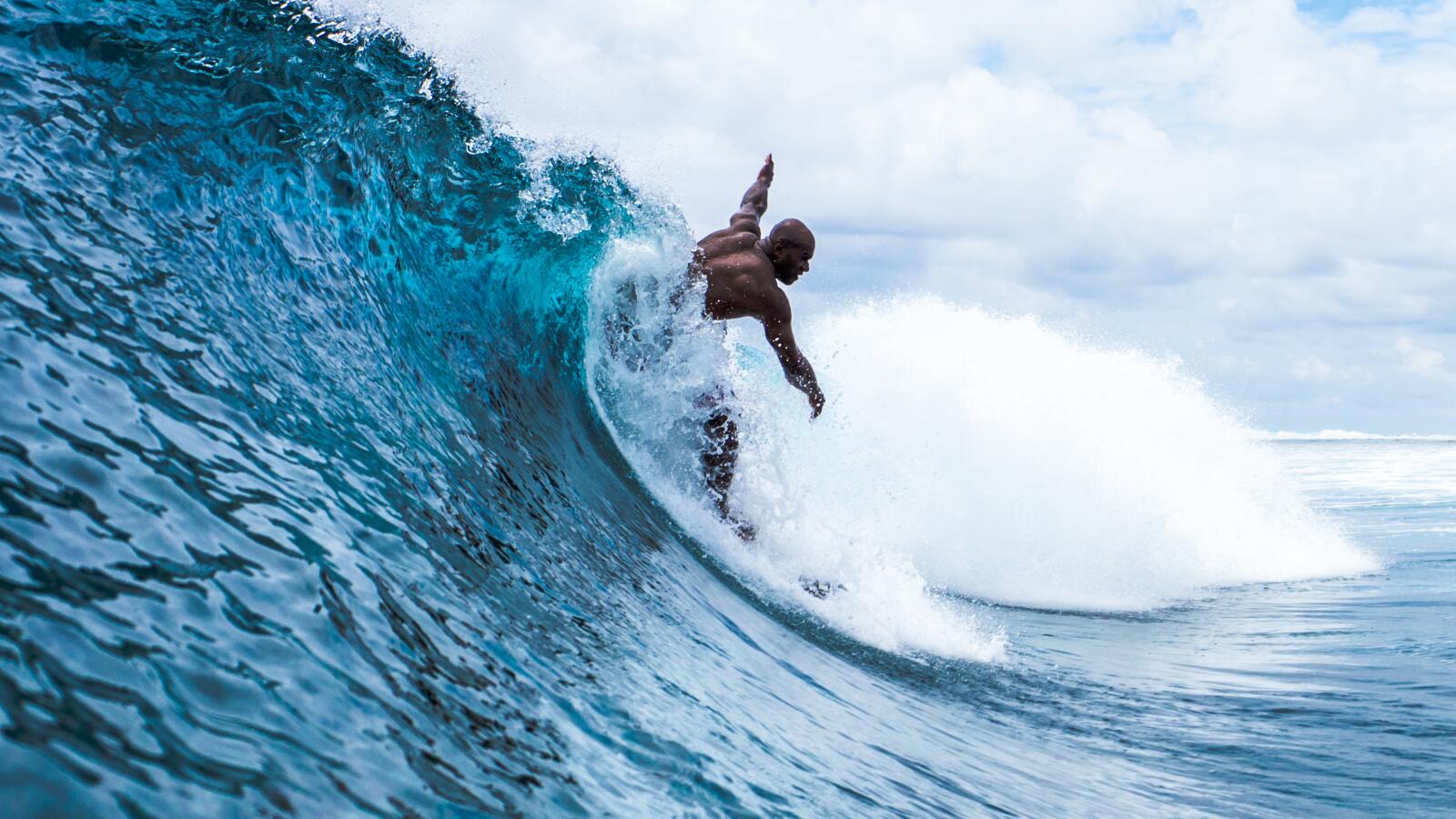
Festivals And Events In Fiji
Fiji's vibrant culture is brought to life through its festivals, which showcase traditional dances, music, food, and community gatherings. Timing your trip to coincide with these events adds depth to your travel experience and offers an authentic glimpse into Fijian customs and celebrations.
Fiji Day Celebrations
10th October 2025
- About the Event: Fiji Day commemorates Fiji's independence from British colonial rule, achieved on October 10, 1970. This national holiday is celebrated across Fiji with pride and joy, as communities come together to honour their heritage.
- Highlights: Celebrations include colourful parades, traditional dance performances, and vibrant displays of Fijian arts and crafts. Visitors can also enjoy cultural storytelling sessions and music showcasing Fiji's diversity, including performances from its Fijian, Indian, and Indo-Fijian communities.
- Where to Go: Major celebrations are held in Suva, the capital, where you'll find the biggest parades and events, but smaller celebrations take place nationwide in local villages and towns.
- What to Expect: Expect a festive atmosphere as locals welcome travellers to join in the fun. Food stalls serve traditional Fijian dishes, such as kokoda (marinated fish) and lovo (meat and vegetables cooked in an earth oven). This is a fantastic time to immerse yourself in Fiji's community spirit.
Hibiscus Festival
August 2025
- About the Event: Known as the "Mother of All Festivals," the Hibiscus Festival is Fiji's largest and oldest cultural festival, celebrated annually for over 60 years. This week-long event celebrates Fiji's natural beauty and combines Fijian customs with modern celebrations, attracting visitors from around the world.
- Highlights: The festival features beauty pageants, traditional dance performances, singing competitions, and a variety of food and craft markets. A major attraction is the Miss Hibiscus Pageant, where contestants from across the Pacific compete for the crown, advocating for causes and showcasing their talents.
- Where to Go: The Hibiscus Festival is primarily held in Suva's Albert Park, which transforms into a vibrant festival ground with stalls, games, and entertainment.
- What to Expect: The festival is family-friendly and offers a mix of traditional and contemporary entertainment. Stalls sell local crafts and street food, providing a perfect opportunity to taste Fijian cuisine. Visitors can also participate in traditional kava ceremonies and observe fire-walking performances.
Bula Festival
July 2025 (TBC)
- About the Event: The Bula Festival, named after Fiji's famous greeting "Bula!" (meaning "hello" or "life"), is a week-long celebration of Fijian hospitality and community. Held in Nadi, it's one of the most popular festivals among locals and tourists.
- Highlights: The festival includes cultural shows, dance performances, beauty contests, and sporting events. Traditional Fijian singing and meke dances (storytelling dances) are performed, along with talent shows and competitions for both children and adults.
- Where to Go: The Bula Festival takes place in Nadi, a major tourism hub, so it's easily accessible for international visitors. Events are held across the town, with main activities centred around Prince Charles Park.
- What to Expect: Experience the warmth of Fijian hospitality as you engage with locals. The Bula Festival is a great opportunity to try traditional Fijian dishes, participate in local dances, and watch competitions. Food stalls offer Fijian favourites like coconut sweets, spicy curries, and BBQ dishes.
Diwali
21st October 2025
- About the Event: Diwali, also known as the Festival of Lights, is celebrated by Fiji's Hindu community. Although a religious festival, it has become widely embraced in Fiji, with lights, decorations, and festivities in various parts of the country.
- Highlights: Homes and temples are decorated with oil lamps (diyas) and colourful rangoli designs made from coloured powders or flower petals. Fireworks, music, and sweet treats are common throughout the celebration.
- Where to Go: Diwali is celebrated across Fiji, especially in towns with a significant Indo-Fijian population, such as Nadi, Suva, and Lautoka.
- What to Expect: Travellers can expect a joyful and festive atmosphere, with opportunities to try delicious sweets like ladoo, barfi, and jalebi. Many local households invite neighbours and visitors to join them for Diwali meals, making it an excellent chance to experience Fijian hospitality and culture.
Holi
14th March 2025
- About the Event: Holi, the Hindu festival of colours, is another significant celebration among Fiji's Indo-Fijian community. This vibrant festival marks the arrival of spring and the triumph of good over evil.
- Highlights: People gather to throw coloured powders (gulal) at each other, sing traditional songs, and celebrate with food. The festival includes dancing, music, and community gatherings where locals welcome everyone to join in the fun.
- Where to Go: Celebrated widely across Fiji, the towns of Lautoka, Suva, and Nadi host lively Holi gatherings.
- What to Expect: Expect a joyful, colourful event with everyone dressed in bright colours. Locals often invite visitors to join the celebrations, making it an ideal time to connect with Fiji's Indo-Fijian community. Traditional snacks and sweets, such as gujiya (sweet dumplings) and samosas, are shared among friends and family.
South Indian Fire Walking Festival
July to August 2025
- About the Event: This ancient festival is held at various South Indian temples in Fiji and is dedicated to the Hindu goddess Draupadi. The event centres around a fire-walking ritual, which symbolises strength, purity, and devotion.
- Highlights: Participants prepare with days of prayer and fasting before performing the fire-walking ritual, walking barefoot over hot coals without injury. The festival includes other traditional rituals, chanting, and offerings to the goddess.
- Where to Go: The most prominent celebration occurs at the Sri Siva Subramaniya Temple in Nadi, Fiji's largest Hindu temple.
- What to Expect: Visitors can witness this powerful ritual, which is accompanied by chanting and prayers. The atmosphere is deeply spiritual, offering a unique glimpse into Fijian Hindu culture. Be respectful of local customs and avoid close-up photography during the ceremony.
When Are Fiji's Best Seasons For Activities?
Fiji's warm, tropical climate makes it a year-round destination, but each season brings unique conditions that enhance certain activities. Whether you're interested in surfing, diving, hiking, or fishing, here's a guide to Fiji's prime seasons for outdoor adventures.
Best Time To Visit Fiji For Surfing - April To October
Prime Season for South Pacific Swells
Season Highlights: The surfing season in Fiji peaks from April to October, thanks to consistent swells generated by the South Pacific. These months bring the most reliable waves, with heights averaging between 4 to 10 feet, making them perfect for surfers of all levels.
Best Surf Spots:
Swimming Pools: Located near Namotu Island, this spot is ideal for beginners and intermediate surfers, offering a mix of gentle and challenging waves.
Off-Peak Surfing (November to March): While April to October is the prime Fiji surfing season, the wet season (November to March) also brings some excellent surf. Although less consistent, these months can still offer good waves, especially during tropical storms that create short, powerful swells. The wet season also means fewer crowds, providing a more relaxed experience.
Travel Tips: Bring your board or rent one locally, as many surf resorts offer high-quality equipment. It's advisable to book surf passes in advance for popular spots like Cloudbreak, as they can be regulated.
Best Time To Visit Fiji For Diving And Snorkelling - June To October
Crystal Clear Waters and Vibrant Marine Life
Season Highlights: June to October is Fiji's dry season and the best time for diving and snorkelling, with minimal rainfall and cooler temperatures leading to exceptional water clarity. Visibility ranges from 20 to 40 metres, allowing divers to fully appreciate Fiji's vibrant coral reefs and diverse marine life.
Best Diving and Snorkelling Spots:
Wet Season Diving (November to April): Although June to October has the clearest water, diving during the wet season offers opportunities to spot unique seasonal species. Warm water attracts different types of marine life, including large schools of fish, turtles, and even hammerhead sharks. The rain enhances underwater visibility in certain areas and brings fewer crowds.
Travel Tips: Many dive operators provide year-round tours. If you're diving in the off-season, be prepared for slightly choppier waters. Always check local Fiji weather and water conditions before booking.
Best Time To Visit Fiji For Hiking And Nature Walks - May To October
Ideal Conditions for Exploring Fiji's Lush Landscapes
Season Highlights: Fiji's dry season (May to October) is perfect for hiking and nature walks. With lower temperatures and reduced humidity, the weather is comfortable for extended outdoor activities. This period also has fewer mosquitoes, making it more enjoyable to explore Fiji's scenic trails.
Top Hiking Destinations:
Wet Season Hiking (November to April): During the wet season, trails become muddy, and some routes may be closed due to safety concerns. However, if you're up for an adventure, the rainy season offers incredibly vibrant scenery. The forests come alive with lush foliage, making it ideal for photography and birdwatching.
Travel Tips: Pack lightweight, breathable clothing and sturdy hiking boots with good grip. Mosquito repellent and sunscreen are essential, as are rain jackets if hiking in the wet season.
Best Time To Visit Fiji For Fishing - November to February
Bountiful Tropical Waters and Migrating Fish
Season Highlights: The fishing season in Fiji peaks from November to February, coinciding with the wet season. Warm water temperatures attract a variety of tropical fish, making this period ideal for fishing enthusiasts. Game fishing for species like marlin, tuna, and mahi-mahi is particularly popular.
Best Fishing Spots:
Off-Peak Fishing (March to October): Although the peak season is in the warmer months, fishing is available year-round in Fiji. During the dry season, you can enjoy reef fishing and catch different species. However, if you're after large pelagic fish like marlin, the best time remains November to February.
Travel Tips: Fiji requires fishing licences for certain areas, so check regulations before planning your trip. Many resorts offer fishing excursions and can arrange licences and equipment for you. If you're an avid fisherman, consider booking a guided fishing charter for the best experience.
By planning your visit around these seasonal insights, you can tailor your trip to Fiji to match your preferred activities, ensuring the most rewarding experience in this tropical paradise. Whether you're surfing the South Pacific swells, diving among vibrant coral reefs, trekking through rainforests, or casting a line for big game fish, Fiji offers unforgettable adventures year-round.
Budget-Friendly Tips and Best Deals
Planning a cost-effective trip to Fiji doesn't mean compromising on experiences. With a bit of planning and awareness of seasonal trends, you can enjoy all that Fiji has to offer at a fraction of the peak-season price. Here's how to maximise your savings and find the best deals year-round.
Off-Peak Deals: Best Value Months - February, March, October, and November
Why These Months? These months are considered Fiji's shoulder and low seasons, when tourist numbers are lower. February and March fall during the wet season, while October and November offer some of the best weather conditions just outside the peak holiday season.
Typical Discounts: Many hotels, resorts, and tour operators offer discounts of 20-50% during these months. Flights are generally cheaper, especially when booked in advance, and popular resorts tend to reduce rates to attract travellers.
Ideal For: Couples, solo travellers, and budget-conscious adventurers who don't mind a little rain or prefer a quieter atmosphere. The slightly lower occupancy at resorts also means you can enjoy facilities without crowds.
Additional Perks: Off-peak travel deals often bundle flights, accommodation, and tours into discounted packages. Look for deals that include complimentary meals, airport transfers, or bonus activities like snorkelling tours or village visits.
Travel Tips: Booking off-peak can be particularly rewarding if you're flexible with travel dates.
Why These Months? July and August coincide with school holidays in Australia and New Zealand, making it a popular time for families to visit Fiji. Many resorts cater to family travellers with special packages designed to enhance the family experience and minimise expenses.
Typical Discounts: While rates may be higher due to demand, resorts offer substantial savings through family packages that include benefits like kids-stay-free policies, free meals for children, and complimentary kids' club access. These can significantly reduce costs for families.
Ideal For: Families looking for a balanced blend of activities, relaxation, and convenience. Resort packages cater to all ages, with activities designed for children and adults.
Additional Perks: Many family packages come with added benefits like access to waterparks, family tours, or cultural activities that are specifically geared towards kids. Resorts often have dedicated kids' clubs, babysitting services, and on-site amenities that keep children entertained while parents relax.
Travel Tips: To make the most of your budget, book family packages early, as they tend to sell out quickly for these peak months. Look for resorts that offer all-inclusive family packages with meals, drinks, and activities bundled in, reducing the need for extra spending.
Why Last-Minute During the Wet Season? The wet season (November to April) is Fiji's quietest period, allowing resorts and tour operators to fill rooms with last-minute discounts. If you're flexible with dates and can travel on short notice, you can often score exceptional deals.
Typical Discounts: Last-minute bookings can save up to 30-50% on rooms and packages. Tours, cruises, and excursions may also offer walk-in rates with significant discounts.
Ideal For: Solo travellers, couples, or small groups who don't mind adjusting their plans for a good deal. This is also ideal for those who don't have strict travel dates and can capitalise on last-minute availability.
Additional Perks: Last-minute bookings may come with added inclusions, such as free room upgrades, dining credits, or complimentary activities. Resorts may also offer free spa treatments or other amenities to encourage guests to stay longer.
Travel Tips: Keep an eye on TravelOnline for the latest deals and exclusive offers on accommodation and packages. If you are already in Fiji and considering extending your stay, explore our website for flexible options or contact us directly to find the best rates and extended stay deals tailored to your needs.
What's Included: All-inclusive packages typically cover accommodation, meals, and a range of activities like snorkelling, cultural tours, and evening entertainment. Some packages even include airport transfers and additional excursions, making them convenient for those wanting a hassle-free vacation.
Best Time for Deals: All-inclusive packages are available year-round but often come with substantial discounts during the shoulder and off-peak months. They're especially popular from April to June and October to November, when resorts try to attract more guests with bundled deals.
Ideal For: Travellers looking to simplify their budgeting. Couples, families, and groups who want to make the most of their resort experience without worrying about extra costs find all-inclusive packages beneficial.
Additional Perks: Many all-inclusive resorts offer unlimited access to activities, kids' clubs, and onsite restaurants, allowing travellers to enjoy multiple dining options without added expenses. Some packages include additional excursions like island hopping or sunset cruises.
Travel Tips: Compare all-inclusive packages carefully to understand what's included and ensure it aligns with your interests. If you enjoy adventure activities, look for packages with tours and excursions. For those who prefer relaxation, choose a package with spa treatments and beachside amenities.
What's Included: Special occasion packages often include romantic perks like candlelit dinners, couples' massages, room upgrades, and private excursions. Many resorts also offer honeymoon and anniversary discounts with unique amenities.
Best Time for Deals: Special occasion packages are available throughout the year but may be discounted during off-peak months. Resorts tend to offer more flexibility with these packages, allowing you to celebrate during quieter seasons for a personalised experience.
Ideal For: Couples celebrating honeymoons, anniversaries, or romantic holiday. These packages are often designed to enhance the romantic experience, with private beach dinners, spa days, and excursions for two.
Additional Perks: Perks often include exclusive experiences like private picnics on secluded islands, personalised services, and access to adult-only areas of the resort.
Travel Tips: Mention your special occasion when booking, as many resorts provide additional complimentary perks for celebrations. Ask about customisations, such as adding a sunset cruise or arranging a private beach dinner, to make the experience even more memorable.
What's Included: Visiting Fiji during major festivals like Fiji Day, the Hibiscus Festival, or the Bula Festival adds free cultural value to your trip, with events like parades, traditional dances, and food fairs accessible to the public.
Best Times for Festivals: Plan around specific festivals - July for the Bula Festival, August for the Hibiscus Festival, and October for Fiji Day celebrations.
Ideal For: Travellers interested in experiencing Fijian culture without added costs. Festival-goers can enjoy cultural experiences that would otherwise be part of paid excursions.
Travel Tips: Check festival dates ahead of time to align your trip with these events. Be sure to explore the local activities and sample traditional foods from street vendors, which is often cheaper and more authentic than dining in restaurants.
There's No Wrong Time to Travel to Fiji
The question isn't when not to go to Fiji, but rather when is the best time for you to go to Fiji. Factoring in things like weather, activities, peak and off-peak periods, and resort availability, will help you determine the best time of year to visit. Fiji is rife with incredible culture, food, and attractions, meaning any holiday to the island nation is sure to be an unforgettable one. Speak to one of our travel consultants about booking a tropical getaway to Fiji today!

